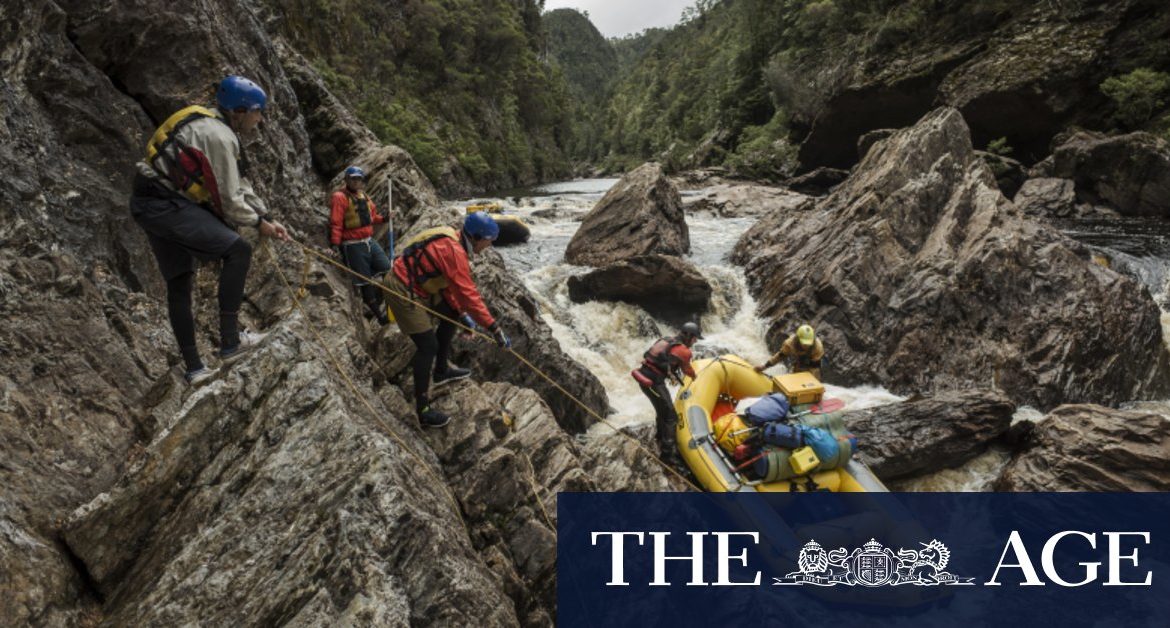You get tired and cold rafting the Franklin, you see. I went in the middle of summer, yet down here on the Apple Isle, subject to the Roaring Forties, I still grew shivery and numb. I got bashed and bruised in this endeavour, dumped and dunked and wearied from paddling all day, then sleeping on rocks under a tarp all night. When signing up for this trip, you have to commit to a certain level of fitness, declaring in a waiver that you’ve done the right amount of exercise in advance. And it’s necessary.
Danger is never far away. As the water cascades it gathers mass, and amasses energy, and as it drops down through rapids with names like Thunderush and Duck Chute it unleashes its frightening force. There are many sections it is simply not safe to go down at all, and so we climbed out of our raft, and scurried up slippery cliffs, or clambered over wet boulders surrounded by furious white water.
Our guides used ropes and ingenuity to “portage” our rafts through the more menacing sections of this place. And they truly are menacing. There are times when you don’t need to be told such things – when you survey the scene and clearly understand that one false step, one slip or stumble, will mean death.
That’s not an exaggeration. Many people have died here, sucked down into the churning waters beneath labyrinthine rock formations. They’ve died at Big Fall, and Pig Trough. The author Richard Flanagan wrote his first novel, Death of a River Guide, based on a drowning at The Cauldron. Flanagan was a river guide himself, and was once almost killed on his kayak after finding himself trapped in an air pocket for hours. To him, the river was “a huge army on the march, overrunning the countryside, taking all before it, collecting ever greater strength from every dripping moss-lined rock face, from every overexcited stream”.
Travelling through this place then teaches you humility, and deference, and resourcefulness. Unlike so many outdoor adventures, the Franklin River experience has not been modulated or mitigated by luxury offerings and accommodations. There are no hidden huts along the way. No points at which helicopters will drop off supplies. No toilet blocks. Not even the most basic lean-to. There is only what you carry with you.
There are no roads or tracks in or out of this place, either. None at all. And it means that once you begin, you must see the trip through to the end. And that’s highlighted by the narrowness of your vision as you make your way down, and the impassable cliffs on either side that reach up to the sky. To see the horizon here is not to peer off into the middle distance, but to look up high, at the barest thin sliver of sky above. On the Franklin, you’re very much hemmed into another world. There’s no hiking out of here – only the imperative to finish.
Rivers are ephemeral, after all. They exist only in motion.
I remember that when I did get near the finish, I felt exhausted but stronger. Exploring caves and chasms covered in fluorescent green moss, I felt as though I understood something more about the richness of things. Surrounded by towering Huon pines and fallen myrtles, like giants’ bones, I felt as though I had learnt something about the scale and scope of life. Rivers are ephemeral, after all. They exist only in motion, and so being on them and in them and feeling their power is a very fleeting thing. I remember someone near the end of our trip coming to that realisation, and letting go of a wistful sigh, sad that they would be back in the real world the following morning. The river guide turned and smiled softly, and spoke to us all. “Mate,” he said, “this is the real world.”
To read more from Good Weekend magazine, visit our page at The Sydney Morning Herald, The Age and Brisbane Times.







